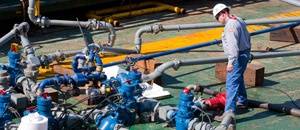|
NEW ORLEANS — BP claimed a key milestone Wednesday Aug 10 in the effort to plug its blown-out well as a government report said much of the spilled oil is "gone," heartening officials who have taken heat during the tricky cleanup but leaving some Gulf Coast residents still skeptical.
BP PLC reported that mud forced down the well overnight was pushing the crude back down to its source for the first time since the Deepwater Horizon rig exploded off Louisiana on April 20, killing 11 workers.
And a federal report being released Wednesday indicated that only about a quarter of the spilled oil remains in the Gulf, with the rest having been contained, cleaned up or otherwise disappeared.
President Barack Obama, while noting that people's lives "have been turned upside down," declared in Washington that the operation was "finally close to coming to an end."
The Skanner News Video - Commander Thad Allen has 'High Confidence'"
The containment effort isn't over. Crews performing the so-called "static kill" effort overnight now must decide whether to follow up by pumping cement down the broken wellhead. Federal officials said they won't declare complete victory until they also pump in mud and then cement from the bottom of the well, and that won't happen for several weeks.
"We've pretty much made this well not a threat, but we need to finish this from the bottom," retired Coast Guard Adm. Thad Allen, the government's point man on the spill response, told WWL-TV in New Orleans.
The Skanner News Video - Obama says static kill "very welcome news'
Nearly three-quarters of the oil — more than 152 million gallons — has been collected at the well by a temporary containment cap, been cleaned up or chemically dispersed, or naturally deteriorated, evaporated or dissolved, according to a report by the Interior Department and the National Oceanic and Atmospheric Administration.
|
"It was captured. It was skimmed. It was burned. It was contained. Mother Nature did her part," White House energy adviser Carol Browner said on NBC's "Today" show.
That leaves about 53.5 million gallons in the Gulf. The amount remaining — or washed up on the shore — is still nearly five times the size of the 11 million-gallon Exxon Valdez spill, which wreaked environmental havoc in Alaska in 1989.
About a quarter of the oil evaporated or dissolved in the warm Gulf waters, the same way sugar dissolves in water, federal officials said. Another one-sixth naturally dispersed because of the way it leaked from the well. Another one-sixth was burned, skimmed or dispersed using controversial chemicals.
More than 205 million gallons gushed from the well in total, according to government estimates. Crews managed to burn, skim or siphon off more than 30 million gallons in the days after.
Charter boat captain Randy Boggs, of Orange Beach, Ala., said Wednesday he has a hard time believing BP's claims of success with the static kill and similarly dismissed the idea that only a quarter of the oil remains in the Gulf.
"There are still boats out there every day working, finding turtles with oil on them and seeing grass lines with oil in it," said Boggs, 45. "Certainly all the oil isn't accounted for. There are millions of pounds of tar balls and oil on the bottom."
In the fishing town of Yscloskey, LA., crabber Oliver Rudesill, 28, said he has been out of business like most of his buddies, some of whom are doing cleanup for BP instead but are earning about a quarter of what they do fishing.
"As soon as BP gets this oil out of sight, they'll get it out of mind, and we'll be left to deal with it alone," he said Tuesday.
In Washington for a meeting with administration officials about the oil spill, Alabama Gov. Bob Riley said federal officials need to understand states' needs going forward.
"Just because the oil has stopped leaking into the Gulf doesn't mean this disaster is over. There is a long way to go and we all need to remain focused on where we go from here," Riley said in a statement.
A 75-ton cap placed on the well in July has been keeping the oil bottled up inside over the past three weeks but was considered only a temporary measure. BP and the Coast Guard wanted to plug up the hole with a column of heavy drilling mud and cement to seal it off more securely.
The static kill — also known as bullheading — involved slowly pumping the mud from a ship down lines running to the top of the ruptured well a mile below. A previous, similar effort failed in May when the mud couldn't overcome the unstemmed flow of oil.
BP won't know for certain whether the static kill has succeeded until engineers can use the soon-to-be-completed relief well to check their work.
In the Gulf, workers stopped pumping mud in after about eight hours of static kill work and were monitoring the well to ensure it remained stable, BP said.
It's a milestone," BP spokeswoman Sheila Williams said. "It's a step toward the killing of the well."
Browner told NBC it was good news that the static kill was working but that "we remain focused on the relief well."
The crew aboard the vessel the Q4000, which was used to pump in the mud, had been eager for the effort to work.
"Being part of the solution is certainly something I hold very close to my heart," Capt. Keith Schultz said.
Weber reported from aboard the Q4000. Contributing to this report were Associated Press writers Dina Cappiello in Washington, Jay Reeves in Birmingham, Ala., Jason Dearen in Yscloskey, La., Bernard McGhee in Atlanta and Robert Barr in London.
Breaking News, Thursday Aug 5
The Skanner News Video - BP Starts Using Cement
The Skanner News Video - Conservationists worry about Dispersants


 "Static Kill" manifold onboard the Q4000
"Static Kill" manifold onboard the Q4000 










































































































































































































































































































